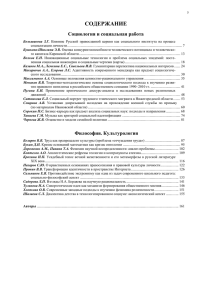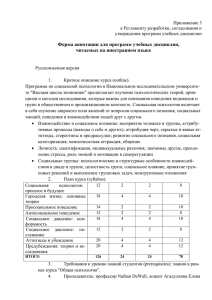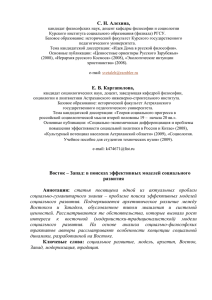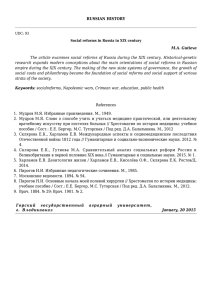глакмен м.
advertisement
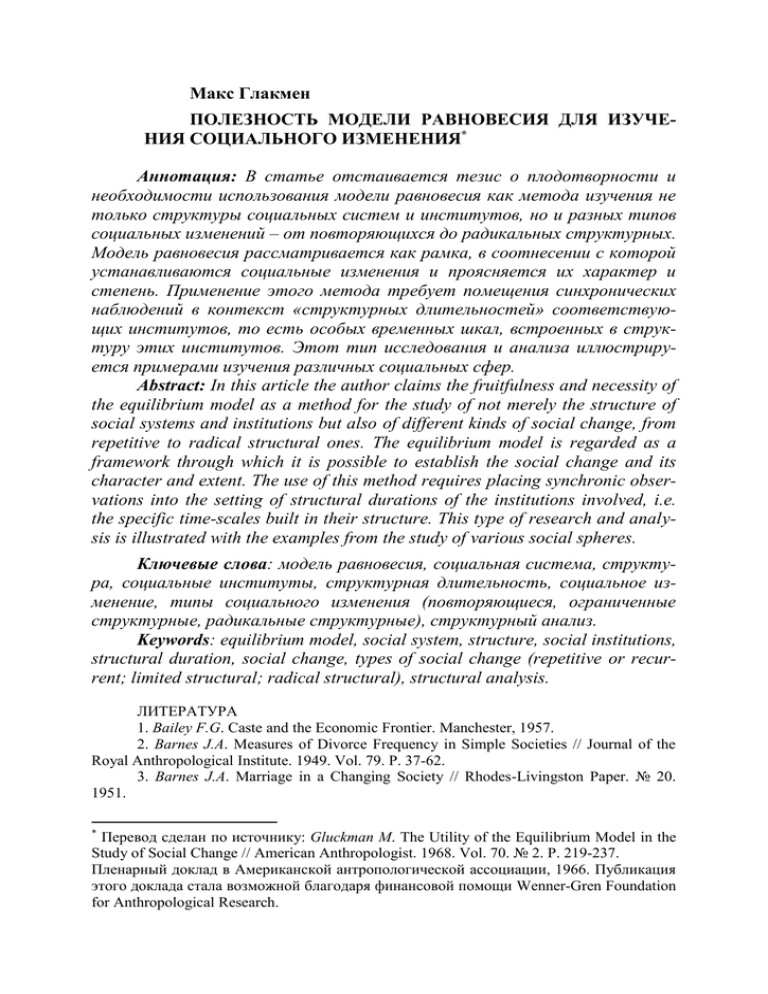
Макс Глакмен ПОЛЕЗНОСТЬ МОДЕЛИ РАВНОВЕСИЯ ДЛЯ ИЗУЧЕНИЯ СОЦИАЛЬНОГО ИЗМЕНЕНИЯ* Аннотация: В статье отстаивается тезис о плодотворности и необходимости использования модели равновесия как метода изучения не только структуры социальных систем и институтов, но и разных типов социальных изменений ‒ от повторяющихся до радикальных структурных. Модель равновесия рассматривается как рамка, в соотнесении с которой устанавливаются социальные изменения и проясняется их характер и степень. Применение этого метода требует помещения синхронических наблюдений в контекст «структурных длительностей» соответствующих институтов, то есть особых временных шкал, встроенных в структуру этих институтов. Этот тип исследования и анализа иллюстрируется примерами изучения различных социальных сфер. Abstract: In this article the author claims the fruitfulness and necessity of the equilibrium model as a method for the study of not merely the structure of social systems and institutions but also of different kinds of social change, from repetitive to radical structural ones. The equilibrium model is regarded as a framework through which it is possible to establish the social change and its character and extent. The use of this method requires placing synchronic observations into the setting of structural durations of the institutions involved, i.e. the specific time-scales built in their structure. This type of research and analysis is illustrated with the examples from the study of various social spheres. Ключевые слова: модель равновесия, социальная система, структура, социальные институты, структурная длительность, социальное изменение, типы социального изменения (повторяющиеся, ограниченные структурные, радикальные структурные), структурный анализ. Keywords: equilibrium model, social system, structure, social institutions, structural duration, social change, types of social change (repetitive or recurrent; limited structural; radical structural), structural analysis. ЛИТЕРАТУРА 1. Bailey F.G. Caste and the Economic Frontier. Manchester, 1957. 2. Barnes J.A. Measures of Divorce Frequency in Simple Societies // Journal of the Royal Anthropological Institute. 1949. Vol. 79. P. 37-62. 3. Barnes J.A. Marriage in a Changing Society // Rhodes-Livingston Paper. № 20. 1951. Перевод сделан по источнику: Gluckman M. The Utility of the Equilibrium Model in the Study of Social Change // American Anthropologist. 1968. Vol. 70. № 2. P. 219-237. Пленарный доклад в Американской антропологической ассоциации, 1966. Публикация этого доклада стала возможной благодаря финансовой помощи Wenner-Gren Foundation for Anthropological Research. * 2 4. Barnes J.A. Politics in a Changing Society: A Political History of the Fort Jameson Ngoni. L., 1954. 5. Barnes J.A. Measures of Divorce Frequency in Simple Societies [revised version of Barnes 1949] // Epstein A.L. (ed.) The Craft of Social Anthropology. L., 1967. 6. Bohannan P.J. Justice and Judgment among the Tiv. L., 1957. 7. Brookfield M.C., Brown P. Struggle for Land: Agriculture and Group Territories among the Chimbu of the New Guinea Highlands. Melbourne, 1963. 8. Cohen P.S. Models // British Journal of Sociology. 1966. Vol. 17. P. 70-78. 9. Cunnison I.G. History of Luapula // Rhodes-Livingston Paper № 21. 1951. 10. Cunnison I.G. Perpetual Kinship: A Political Institution of the Luapula Peoples // Rhodes-Livingston Journal. 1956. Vol. 20. P. 28-28. 11. Cunnison I.G. History and Genealogies in a Conquest State // American Anthropologist. 1957. Vol. 59. P. 20-31. 12. Cunnison I.G. The Luapula Peoples of Northern Rhodesia: Custom and history in Tribal Politics. Manchester, 1959. 13. Devons E., Gluckman M. Introduction and Conclusion // Gluckman M. (ed.) Closed Systems and Open Minds. Chicago, 1964. 14. Eggan F., Gluckman M. Introduction // Banton M. (ed.) New Approaches in Social Anthropology. L., 1965, 1966. 15. Evans-Pritchard E.E. Witchcraft, Oracles and Magic among the Azande. Oxford, 1937. 16. Evans-Pritchard E.E. The Nuer: A Description of the Modes of Livelihood and Political Institutions of a Nilotic People. Oxford, 1940. 17. Evans-Pritchard E.E. The Sanusi of Cyrenaica. Oxford, 1949. 18. Firth R. We, the Tikopia. L., 1936. 19. Firth R. Social Change in Tikopia. L., 1959. 20. Fortes M. The Dynamics of Clanship among the Tallensi. L., 1945. 21. Fortes M. The Web of Kinship among the Tallensi. L., 1949. 22. Fortes M. Time and Social Structure // Fortes M. (ed.) Social Structure: Essays Presented to A.R. Radcliffe-Brown. L., 1949. 23. Fortes M. (ed.) Marriage in Tribal Societies // Cambridge Papers in Social Anthropology. № 3. 1962. 24. Frankenberg R.J. Village on the Border. L., 1958. 25. Gluckman M. The Kingdom of the Zulu of South Africa // Fortes M., EvansPritchard E.E. (eds.) African Political Systems. L., 1940. 26. Gluckman M. Analysis of a Social Situation in Modern Zululand // Bantu Studies. 1940. Vol. 14. P. 1-30, 147-174. (Переиздано как: Rhodes-Livingstone Paper № 28. 1958.) 27. Gluckman M. Some Processes of Social Change Illustrated from Zululand // African Studies. 1942. Vol. 1. P. 243-260. (Переиздано в: Rhodes-Livingstone Paper № 28. 1958.) 28. Gluckman M. Essays on Lozi Land and Royal Property // Rhodes-Livingstone Paper № 10. 1943. 29. Gluckman M. Kinship and Marriage among the Lozi of Northern Rhodesia and the Zulu of Natal // Radcliffe-Brown A.R., Forde C.D. (eds.) African Systems of Kinship and Marriage. L., 1950. 30. Gluckman M. Order and Rebellion in Tribal Africa. Glencoe, Ill.; L., 1963. 31. Gluckman M. (ed.) Closed Systems and Open Minds. Chicago; Edinburgh, 1964. 32. Gluckman M. Politics, Law and Ritual in Tribal Society. Chicago; Oxford, 1965. 33. Gluckman M. The Ideas in Barotse Jurisprudence. New Haven, 1965. 3 34. Gluckman M. Tribalism, Ruralism and Urbanism in Changing Africa // Turner V.W. (ed.) Profiles of Change: The Impact of Colonialism on African History. Cambridge, 1969. 35. Gluckman M. Social and Moral Crises: Magical and Secular Solutions. The Marett Lectures, 1964, 1965 // Gluckman M. (ed.) Allocation of Responsibility. Manchester, 1969. 36. Goffman E. The Presentation of Self in Everyday Life. University of Edinburgh Social Sciences Research Centre, Monograph № 2. 1956. 37. Goffman E. Encounters. Indianapolis, 1961. 38. Goody E. Conjugal Separation and Divorce among the Gonja of Northern Ghana // Fortes M. (ed.) Marriage in Tribal Societies / Cambridge Papers in Social Anthropology № 3. 1962. 39. Goody J. (ed.) The Developmental Cycle in Domestic Groups / Cambridge Papers in Social Anthropology № 2. 1958. 40. Homans G.C. The Human Group. N.Y., 1950. 41. Leach E.R. Political Systems of Highland Burma: A Study of Kachin Social Structure. L., 1954. 42. Leach E.R. Political Systems of Highland Burma: A Study of Kachin Social Structure [2nd ed., with a new “Introduction”]. L., 1964. 43. Malinowski B. Culture // Encyclopedia of the Social Sciences. N.Y., 1931. Vol. 5. P. 621-646. 44. Malinowski B. A Scientific Theory of Culture. Chapel Hill, 1944. 45. Mandelbaum M. Societal Facts // British Journal of Sociology. 1955. Vol. 6. № 4. P. 305-317. 46. Mandelbaum M. A Note on History as Normative // History and Theory. 1967. Vol. 6. № 3. P. 413-419. 47. Marwick M.G. Sorcery in Its Social Setting. Manchester: Manchester University Press, 1965. 48. Meggitt M.J. The Lineage System of the Mae Enga of the New Guinea Highlands. Edinburgh, 1965. 49. Merton R.K. Social Theory and Social Structure [2nd ed. revised and enlarged]. Glencoe, Ill.: Free Press, 1957. 50. Middleton J., Winter E. (eds.) Witchcraft and Sorcery in East Africa. L., 1963. 51. Miner H. Body Ritual among the Nacirema // American Anthropologist. 1956. Vol. 56. P. 503-507. 52. Mitchell J.C. The Yao of Southern Nyasaland // Colson E., Gluckman M. (eds.) Seven Tribes of British Central Africa. L., 1951. 53. Mitchell J.C. An Outline of the Social Structure of Malemia Ward // The Nyasaland Journal. 1951. Vol. 5. P. 51-58. 54. Mitchell J.C. The Yao Village. Manchester, 1956. 55. Mitchell J.C. Marriage Stability and Social Structure in Bantu Africa // International Population Conference, New York, 1961. L., 1963. Vol. 2. P. 255-263. 56. Mitchell J.C. Theoretical Orientations in African Urban Studies // Banton M. (ed.) The Social Anthropology of Complex Societies / ASA Monographs, № 4. 1966. P. 37-68. 57. Nadel S.F. The Nuba. L., 1947. 58. Nadel S.F. Nupe Religion. L., 1954. 59. Peters E.L. The Proliferation of Segments in the Lineage of the Bedouin of Cyrenaica // Journal of the Royal Anthropological Institute. 1960. Vol. 90. P. 29-53. 60. Peters E.L. Some Structural Aspects of the Feud among the Camel-Herding Bedouin of Cyrenaica // Africa. 1967. Vol. 35. № 2. P. 261-282. 4 61. Pospisil L. Kapauka Papuans and Their Law / Yale University Publications in Anthropology, № 54. 1958. 62. Pospisil L. Social Change and Primitive Law: Consequences of a Papuan Legal Case // American Anthropologist. 1958. Vol. 60. P. 832-837. 63. Pospisil L. Papuan Social Structure: Rejoinder to Leach // American Anthropologist. 1960. Vol. 62. P. 690-691. 64. Reay M. The Kuma. Melbourne, 1959. 65. Richards A.I. Mother-Right in Central Africa // Evans-Pritchard E.E., Firth R., Malinowski B., Schapera I. (eds.) Essays Presented to C.G. Seligman. L., 1933. 66. Sahlins M.D. The Segmentary Lineage: An Organization of Predatory Expansion // American Anthropologist. 1961. Vol. 63. P. 322-345. 67. Salisbury R.F. From Stone to Steel: Economic Consequences of a Technological Change in New Guinea. L., 1962. 68. Smelser N.J. Social Change in the Industrial Revolution. L., 1959. 69. Turner V.W. Schism and Continuity in an African Society. Manchester, 1957. 70. Van Velsen J. The Politics of Kinship: A Study in Social Manipulation among the Lakeside Tonga of Nyasaland. Manchester, 1964. 71. Vogt E.Z. On the Concept of Structure and Process in Cultural Anthropology // American Anthropologist. 1960. Vol. 62. P. 18-33. 72. Watson W. Tribal Cohesion in a Money Economy. Manchester, 1958. 73. Wilson M. Witch Beliefs and Social Structure // American Journal of Sociology. 1951. Vol. 56. P. 307-313. ПРИМЕЧАНИЯ 1. Я благодарен профессорам Дж.А. Барнсу и М. Фортесу, с которыми у меня были полезные предварительные обсуждения проблем, поднятых в этой статье, а также моим манчестерским коллегам (П. Бакстеру, К. Гарбетту, Б. Капфереру, Н. Лонгу, Дж.К. Митчеллу, Э.Л. Петерсу, М. Саутволду, Р. Вербнеру), которые прокомментировали на семинаре первоначальную рукопись и привнесли в нее много ценного. Полезную помощь оказали мне коллеги по Центру продвинутого изучения поведенческих наук в Стэнфорде, а Центр предоставил много возможностей для моей работы. Профессор Салли Ф. Мур помогла мне на этапе завершения статьи конструктивной критикой. 2. Схожий действенный аргумент см., среди прочих, у Смелзера [68]. 3. Этот аргумент проработан в публикациях [31], [32] и [14]. 4. Ср. с точкой зрения Малиновского на институты [43; 44]. 5. См. о внешней среде у Хоманса [40, 81 и далее]. 6. Обобщающее обсуждение этой общей проблемы содержится в моей публикации [33, 101 ff.]. Франкенберг [24] применил освещенный здесь общий тезис ЭвансПритчарда для прояснения роли «чужаков» и «посторонних» в общинной жизни уэльской деревни. 7. «Дендритический» значит растущий на манер дерева; при этом некоторые ветви продолжают расти. В случае больших деревень в этих процессах нет циклов развития, но в некоторых меньших по размеру деревнях такой цикл есть. 8. Обратим внимание на то, что, хотя книга Меггитта была опубликована в 1965 г., она ушла в печать до выхода в свет книги Брукфилда и Брауна; следовательно, он не мог учесть их критику в адрес формулировки этой гипотезы в одном из ранних его очерков. 9. Я применил это положение к развитию совершенно разных типов социальных отношений между белыми и черными и внутри групп белых и черных в своем «Анали- 5 зе социальной ситуации в современном Зулуленде» (впервые опубликован в 1940 и 1942 гг., переиздан в 1958 г.). 10. Некоторые из этих открытий анализируются Эванс-Притчардом [15], Уилсоном [73], Нэделом [57; 58], Митчеллом [54], Боханнаном [6], Тернером [69], Марвиком [47], Мидлтоном и Уинтером [50], Глакменом [33; 34; 35]. 11. Обсуждение этого момента и следующего далее аргумента см. у Смелзера [68] в главах II и III. 12. Основная часть моего анализа представлена в трех больших очерках. Черновик моей книги и выписки о зулусах из архивов сгорели в пожаре, уничтожившем мой лагерь в Баротселенде. С тех пор я был занят баротсе и книгами общего характера, но сейчас сдаю в печать полновесное исследование периода ранних племен и тогдашних связей с белыми, а также рождения и установления Зулусского королевства. 13. См. различные работы Гоффмана. 14. См. [13]; более ясное изложение см. у Мандельбаума [45]. Пер. с англ. В.Г. Николаева Николаев Владимир Геннадьевич – кандидат социологических наук, доцент социологического факультета Государственного университета «Высшая школа экономики» (Москва). Наш постоянный автор и переводчик. E-mail: vnik1968@yandex.ru.

